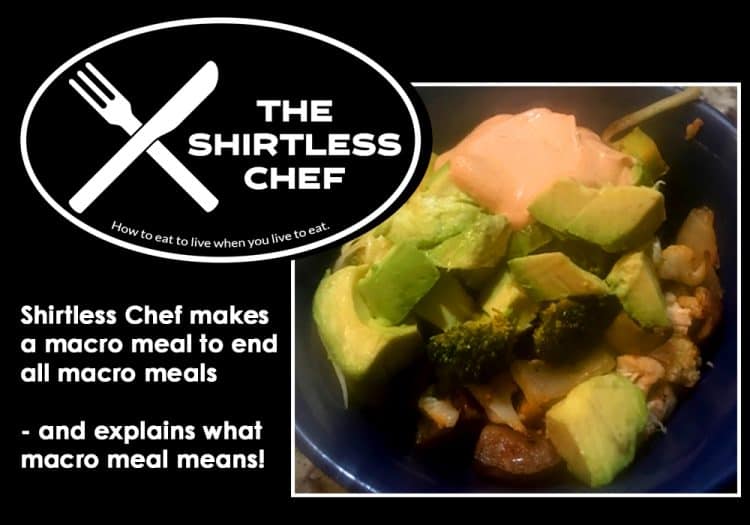There’s a popular phrase in the fitness influencer world that comes up almost as much as the “Do you even lift, bro?” question. The phrase is “Don’t worry about calories, just hit your macros.”
Just taking that as a stand alone statement, it’s not very helpful. It might leave you wondering what exactly is a macro, how would one go about hitting said macro, and why would I not have to worry about calories if I were to catch a macro with a decent left jab or maybe even a wicked uppercut? To make sense of it all, a macro is just one of the big three when it comes to what makes up a calorie. It’s just another way of asking how much fat, protein, and carbs you eat in a day. How many of each you need varies significantly depending on your goals, exercise program, and whatever diet strategy you are using as your daily meal plan.
Weightlifters, for instance, eat a surprisingly big number of carbs compared to what you might think, with that macro being vilified for the most part as of late. Building muscles need carbs, both for the energy to lift and the ability to recover and grow, so a keto approach to macros of 70 percent fats, 20 percent protein, and 10 percent carbs isn’t going to work for someone trying to add muscle. When I started my weight loss journey, I went extreme with about 70 percent protein, then split carbs and fats at 15 percent each as my target. However, to lose weight, you have to be in a calorie deficit, so the whole “You don’t have to worry about calories” part of macros is not an accurate statement. So I also was extremely low calorie during that first phase, and that helped me drop 80 lbs. in a hurry, but it also came with some issues and is not something to be sustained over time.
Now I’m in the dreaded “maintenance” phase where I’m exactly at my target and I’m just trying to maintain this level of fitness and body fat percentage. I’ve found that a more balanced approach to macros helps me maintain my health and all around fitness. We need all three to really feel good and be healthy. The trick is to make sure the macros you are getting are from high quality, nutritious foods. Getting my carbs from veggies and fruits makes a big difference than getting them from sodas and snack cakes.
I developed this one sheet pan meal to be a perfect balance of healthy proteins, carbs, fats, not to mention loads of vitamins, fiber, and gut healthy probiotics. I use a roasting method on the veggies, and if I haven’t converted any of you cauliflower haters yet, this is the one to try. It’s impossible not to roast cauliflower with smoked paprika, then cover it with a little cheese and crumbled bacon and not find it absolutely delicious. And before you throw your phone across the room in disgust, just know I was one of you, possibly even your King and leader of the Not Eating Cauliflower Society. When I abdicated the throne of the junk food carbs for the more delectable roasted veggie carbs, the results became fairly obvious:
I hope if you are wanting to make a change but haven’t tried it yet, that this is the one you take for a test drive. As always, the quality of the finished product will depend on the quality of ingredients you use, so choose wisely and go with the best option you can. I can’t stress this enough, industrial raised mass produced chicken meat is not very healthy. Seek out and find local sourced poultry that is pasture raised if at all possible.
Go to Farmers markets, find online sources, go to Whole Foods, travel all roads you can to avoid the mutant Godzilla like chicken breasts at the big chain mega-marts. The difference is astonishing, in taste, texture, and nutrition. I’m sure you are all familiar with buying regular chicken breasts that are gigantic, pale white, have prominent white stripes throughout the meat, and have a tough and rubber like texture before and after cooking. That comes from keeping a chicken in a tiny cage, force-feeding it cornmeal laced with growth hormones and additives, and never getting one step of exercise. Those white lines in the meat? Those are fatty deposits from a muscle disorder brought on from a process the industry has developed to grow a chicken to six pounds in half the time it does in nature. Those breasts contain 224 percent more fat, less protein, and more calories than a bird that gets to grow up in a field at a normal rate. Here is what the average chicken breasts looks like from the big meat producers:
Here are chicken breasts I buy from local sourced, pasture raised birds that get to chase bugs and grow up at a normal rate:
See the difference in color and texture? The size is also much smaller, so you don’t have to pound it flat into mush in order for it to cook evenly. It also means juicy, tender, and delicious chicken every single time. This actually tastes like chicken, and given the choice, I’d much rather pay a little extra to help a small, local farmer raising animals the ethical way instead of making some corporate giant get even more rich than they already are by selling us inferior, abused animals and products.
I’ll step down off my soapbox now and get to the recipe. I hope you enjoy.
Grilled chicken with roasted veggies sheet pan meal:
Ingredients:
- 1 large organic head of cauliflower
- 1 package purple potatoes
- 3 bunched organic broccoli
- 1 package organic baby bella mushrooms
- 1 large yellow onion
- Diced avocado
- 4 – 5 pasture raised local sourced chicken breasts
- 3 strips pasture raised all natural bacon
- Grass fed plain greek yogurt
- Sea salt, pepper, garlic and onion powder, smoked paprika
- Avocado or olive oil
- 4 oz shredded grass fed cheddar cheese
Instructions:
Pre-heat the oven to 425 degrees. Wash and cut the cauliflower into florets. Wash, dry and cut the purple potatoes into fourths, then combine with the cauliflower in a large bowl. Drizzle with a tablespoon of oil and season with a 1/2 teaspoon of salt, pepper, garlic and onion powder, and 1 tablespoon of smoked paprika. Roast for 20 minutes on a large sheetpan lined with parchment paper.
While that is cooking, wash and cut broccoli into florets, wash and cut mushrooms, and dice the onion into medium large wedges. Repeat the same mixing procedure as for the cauliflower. When the 20 minutes is up, pull the sheet pan, stir the cauliflower/potatoes and then add the broccoli, mushrooms, and onion mixture to the pan, stirring to combine, Roast another 20 minutes, stirring again after 10 minutes.
Trim your chicken breasts of any visible fat and sprinkle each side with the same spices as above to taste. I go by if I can see a good coat of each spice on each side, I’m right where I need to be. If you have a handy-dandy outside electric smoker/grill, use it and cook for 8 – 10 minutes on each side until a temp of 170 is reached:
If you don’t have an electric grill, you can roast in the oven for the same amount of time, or pan cook the chicken on the stove top if necessary. Once the chicken is cooked, transfer to a plate and cover loosely with foil to rest while the veggies finish up in the oven.
When you bring the chicken in to rest, prepare for unsolicited help to be offered by any fuzz faced friends you might have.
Cook the bacon either in the microwave or on stovetop until crispy and set aside. Once the veggies are done, slice the chicken breasts on the bias against the grain:
Then add the sliced chicken to the sheetpan, cover with shredded cheese and pop back in the oven for 2-3 minutes until the cheese is melted. Then crumble the bacon over the top.
I like to serve mine in a bowl with some diced avocado and a quick greek yogurt sauce. Just take a 1 1/2 cups of plain greek yogurt, season with 1/2 teaspoon of the same spices used for this recipe, add a splash of liquid smoke and a squeeze of dijon mustard, and stir to combine.
See more of the Shirtless Chef recipes at www.mysaline.com/shirtless.















